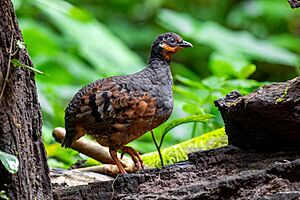Chestnut-bellied partridge facts for kids
Quick facts for kids Chestnut-bellied partridge |
|
|---|---|
 |
|
| In East Java, Indonesia | |
| Conservation status | |
| Scientific classification | |
| Genus: |
Arborophila
|
| Species: |
javanica
|
The chestnut-bellied partridge (scientific name: Arborophila javanica) is a small, colorful bird. It's also known as the chestnut-bellied hill-partridge or Javan hill-partridge. This bird is about 28 centimeters (11 inches) long.
It has a reddish-brown cap and neck, with bright red legs. Its chest is grey, and its wings are brown. You might notice its red skin around the face and a black mask, throat, and beak. Its belly is reddish-brown with a white patch in the middle. Male and female partridges look very similar. Young birds have a lighter face and a reddish-brown beak.
This special partridge lives only in Indonesia, specifically in the hill and mountain forests of Java. It's an "endemic" species, meaning it's found nowhere else in the world. The female partridge lays up to four eggs. She builds a dome-shaped nest from long grasses, often with help from the male.
The chestnut-bellied partridge is quite common in the areas where it lives. Because of this, it is listed as "Least Concern" on the IUCN Red List. This means it is not currently at risk of disappearing.
Contents
About the Chestnut-bellied Partridge
What Does It Look Like?
The chestnut-bellied partridge is a medium-sized bird. It has a unique look that helps it blend into its forest home. Its head and the back of its neck are a reddish-brown color. Its legs are bright red, which stands out against its grey chest and brown wings.
Around its eyes, it has red skin, almost like a mask. Its throat and beak are black. The most noticeable feature is its belly, which is a rich reddish-brown. In the middle of its belly, there's a patch of white feathers. Both male and female partridges look alike, which is not always common in birds. Young partridges have a whitish face and a reddish-brown beak.
Where Does It Live?
This partridge is an "endemic" bird of Indonesia. This means you can only find it in one specific place in the world. For the chestnut-bellied partridge, that place is the island of Java. It prefers to live in the hill and mountain forests of both western and eastern parts of the island. These forests provide the perfect home with plenty of trees and plants for shelter and food.
How Does It Nest?
When it's time to have babies, the female chestnut-bellied partridge builds a special nest. It's shaped like a dome and made from long grasses. The male partridge often helps with building this cozy home. The female usually lays up to four eggs inside the nest.
Is It Endangered?
The chestnut-bellied partridge is considered a "common species" within its home range. This is good news! The IUCN Red List of Threatened Species keeps track of how many animals are left in the wild. They have evaluated this partridge and given it a status of "Least Concern." This means that, for now, there are enough of these birds, and they are not in danger of becoming extinct.
Naming the Partridge
Who Named This Bird?
The chestnut-bellied partridge was first officially described in 1789. A German scientist named Johann Friedrich Gmelin gave it its scientific name. He included it in his updated version of a famous book called Systema Naturae by Carl Linnaeus. Gmelin first put this bird in a group with other grouse-like birds. He gave it the scientific name Tetrao javanicus.
Gmelin used information from an English scientist named Peter Brown. Brown had described and drawn the "Javan partridge" in 1776. Later, in 1837, another English scientist named Brian Houghton Hodgson created a new group, or "genus," called Arborophila. The chestnut-bellied partridge is now one of about twenty species in this group.
What Does Its Scientific Name Mean?
The genus name Arborophila comes from two older words. "Arbor" is a Latin word meaning "tree." "Philos" is an Ancient Greek word meaning "loving." So, Arborophila basically means "tree-loving." This makes sense because these partridges live in forests!
Different Kinds of Chestnut-bellied Partridges
Scientists recognize two slightly different types, or "subspecies," of the chestnut-bellied partridge:


